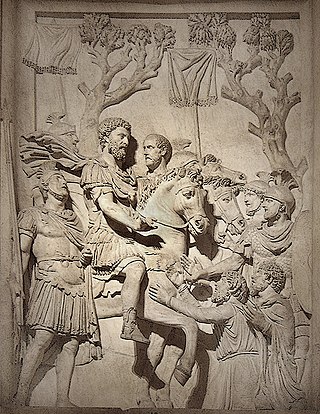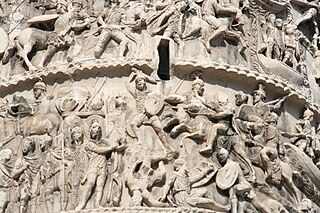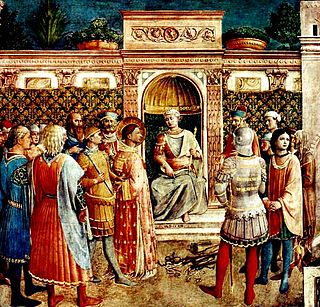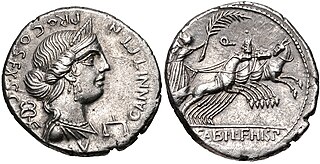Related Research Articles

Marcus Aurelius Antoninus was Roman emperor from 161 to 180 and a Stoic philosopher. He was a member of the Nerva–Antonine dynasty, the last of the rulers later known as the Five Good Emperors and the last emperor of the Pax Romana, an age of relative peace, calm, and stability for the Roman Empire lasting from 27 BC to 180 AD. He served as Roman consul in 140, 145, and 161.

The 120s was a decade that ran from January 1, AD 120, to December 31, AD 129.
The 140s decade ran from January 1, 140, to December 31, 149.
The 160s decade ran from January 1, 160, to December 31, 169.
Year 166 (CLXVI) was a common year starting on Tuesday of the Julian calendar. At the time, it was known as the Year of the Consulship of Pudens and Pollio. The denomination 166 for this year has been used since the early medieval period, when the Anno Domini calendar era became the prevalent method in Europe for naming years.
Year 169 (CLXIX) was a common year starting on Saturday of the Julian calendar. At the time, it was known as the Year of the Consulship of Senecio and Apollinaris. The denomination 169 for this year has been used since the early medieval period, when the Anno Domini calendar era became the prevalent method in Europe for naming years.

Lucius Aurelius Verus was Roman emperor from 161 until his death in 169, alongside his adoptive brother Marcus Aurelius. He was a member of the Nerva–Antonine dynasty. Verus' succession together with Marcus Aurelius marked the first time that the Roman Empire was ruled by more than one emperor simultaneously, an increasingly common occurrence in the later history of the Empire.

Tiberius Claudius Pompeianus was a politician and military commander during the 2nd century in the Roman Empire. A general under Emperor Marcus Aurelius, Pompeianus distinguished himself during Rome's wars against the Parthians and the Marcomanni. He was a member of the imperial family due to his marriage to Lucilla, a daughter of Marcus Aurelius, and was a key figure during the emperor's reign. Pompeianus was offered the imperial throne three times, though he refused to claim the title for himself.

Annia Galeria Faustina the Younger was Roman empress from 161 to her death as the wife of emperor Marcus Aurelius, his maternal cousin. Faustina was the youngest child of emperor Antoninus Pius and empress Faustina the Elder. She was held in high esteem by soldiers and her husband as Augusta and Mater Castrorum and was given divine honours after her death.

Annia Aurelia Galeria Lucilla or Lucilla was the second daughter of Roman emperor Marcus Aurelius and Roman empress Faustina the Younger. She was the wife of her father's co-ruler and adoptive brother Lucius Verus and an elder sister to later emperor Commodus. Commodus ordered Lucilla's execution after a failed assassination and coup attempt when she was about 33 years old.

The Marcomannic Wars were a series of wars lasting from about AD 166 until 180. These wars pitted the Roman Empire against principally the Germanic Marcomanni and Quadi and the Sarmatian Iazyges; there were related conflicts with several other Germanic, Sarmatian, and Gothic peoples along both sides of the whole length of the Roman Empire's northeastern European border, the river Danube.
Marcus Annius Verus was the paternal grandfather and adoptive father of the Roman Emperor Marcus Aurelius, and father-in-law of emperor Antoninus Pius.

Marcus Annius Verus Caesar was a son of Roman Emperor Marcus Aurelius and Empress Faustina the Younger. Annius was made caesar on 12 October 166 AD, alongside his brother Commodus, designating them co-heirs of the Roman Empire. Annius died on 10 September 169, at age seven, due to complications from a surgery to remove a tumor from under his ear. His death left Commodus as the sole heir.
Annia Galeria Aurelia Faustina was a daughter of Roman emperor Marcus Aurelius and his wife, Faustina the Younger. Her sister was empress Lucilla and her younger brother was Commodus. Her maternal grandparents were Antoninus Pius and Faustina the Elder, while her paternal grandparents were Domitia Lucilla and the praetor Marcus Annius Verus. She was born and raised in Rome.

Quintus Junius Rusticus, was a Roman teacher and politician. He was probably a grandson of Arulenus Rusticus, who was a prominent member of the Stoic Opposition. He was a Stoic philosopher and was one of the teachers of the emperor Marcus Aurelius, whom Aurelius treated with the utmost respect and honour.
The Roman–Parthian War of 161–166 was fought between the Roman and Parthian Empires over Armenia and Upper Mesopotamia. It concluded in 166 after the Romans made successful campaigns into Lower Mesopotamia and Media and sacked Ctesiphon, the Parthian capital.

The reign of Marcus Aurelius began with his accession on 7 March 161 following the death of his adoptive father, Antoninus Pius, and ended with his own death on 17 March 180. Marcus first ruled jointly with his adoptive brother, Lucius Verus. They shared the throne until Lucius' death in 169. Marcus was succeeded by his son Commodus, who had been made co-emperor in 177.

The gens Annia was a plebeian family at ancient Rome. Livy mentions a Lucius Annius, praetor of the Roman colony of Setia, in 340 BC, and other Annii are mentioned at Rome during this period. Members of this gens held various positions of authority from the time of the Second Punic War, and Titus Annius Luscus attained the consulship in 153 BC. In the second century AD, the Annii gained the Empire itself; Marcus Aurelius was descended from this family.

Gaius Julius Sohaemus was a Roman client king of Armenia.
Bakur, also known as Aurelius Pacorus or Pacorus was a Parthian Prince who served as one of the Kings of Armenia in the 2nd century.
References
- ↑ "Who Is Junius Rusticus? An Introduction To The Philosopher King's Teacher". Daily Stoic. September 17, 2020. Retrieved August 6, 2021.
- ↑ Dershowitz, Nachum (1990). "Calendrical Calculations". Software: Practice and Experience. 20 (9 September): 899–928 [903]. CiteSeerX 10.1.1.404.2348 . doi:10.1002/spe.4380200905. S2CID 44801940.
- ↑ Tsouras, Peter (July 20, 2017). "Rome's Parthian War, A.D. 161-166". HistoryNet. Retrieved August 6, 2021.
- ↑ Stephens, William O. (2012). Marcus Aurelius: a Guide for the Perplexed. New York: Continuum International Publications Group. ISBN 9781441108104.
- ↑ "Marcus Aurelius - Livius". www.livius.org. Archived from the original on November 6, 2013. Retrieved January 2, 2018.
Indica in Greek at the Perseus Digital Library, http://data.perseus.org/citations/urn:cts:greekLit:tlg0074.tlg002.perseus-grc1:1
Indica in Greek with side-by-side English translation at the Loeb Classics Library, https://www.loebclassics.com/view/arrian-indica/1983/pb_LCL269.307.xml